Joshua's Seventieth Jubilee
by John P. Pratt
Reprinted from Meridian Magazine (18 May 2006).
©2006 by John P. Pratt. All rights Reserved.
Index,
Home
Soon we can celebrate seventy jubilees since Joshua crossed the River Jordan.
Joshua led the children of Israel into the promised land of Canaan after the Lord divided the waters
of the Jordan River for them to cross on dry ground. This miraculous event was similar to the
parting of the Red Sea by Moses, and surely was a convincing sign to all that he was now God's
new chosen leader. The date of that event is precisely given in scripture using their calendar at that
time: it was the 10th day of the first month (later called Nisan), forty years after the Exodus from
Egypt (Joshua 4:19; 5:6). On that very day, the Lord commanded them to circumcise all of
their males who had been born in the wilderness (Joshua 5:2). On the Hebrew calendar, that day
10 Nisan (Consecration) is one of two days each year which is especially appropriate for making a
covenant with God, the other being the Day of Atonement. Correlating that day to our calendar
implies that Joshua passed over Jordan on Mon 12 Apr 1422 BC.[1]
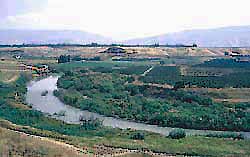 |
The River Jordan
An extremely impressive anniversary of that date is approaching. Mon 6 Apr 2009 will mark
exactly seventy jubilees on the (Perpetual) Hebrew Calendar since that date.[2] The year
of the jubilee has been lost to modern Hebrews, but the results of my research indicate that the
jubilee year occurred in that very year of entering the Promised Land. The Lord told Moses to
begin counting sabbath years and the jubilee cycle when they entered the promised land (Lev. 25),
which suggests beginning the count immediately at that time.[3] The jubilee
is the fiftieth year after the cycle begins, but the cycle only has seven sets of seven years, or 49
years. Thus, the 50th year of the cycle is the same as the first year of the cycle.[4] That
and several other events indicate that they indeed entered the promised land in a jubilee year.[5] The year 2009 marks 70 sets of 49-year jubilee cycles since 1422 BC.[6]
There were many key events in the history of Israel which occurred during the final year in the
wilderness and then shortly after crossing the Jordan. Let's consider several of them so that we
might remember each during the coming jubilee year.
1. Events to Remember
In the Lord's reckoning, both the first and the last are sacred (D&C 29:30). In the 49-year jubilee cycle, both the first year (the jubilee year) and the last year (the 49th year) are important. At the time of Moses
with the children of Israel, several key events occurred in the last of the forty years in the
wilderness, which was the 49th year of the jubilee cycle. Then several more events occurred during the
following (jubilee) year. One tricky point here is that the 40th year in the wilderness was counted
from spring to spring, whereas the jubilee year begins in the autumn.
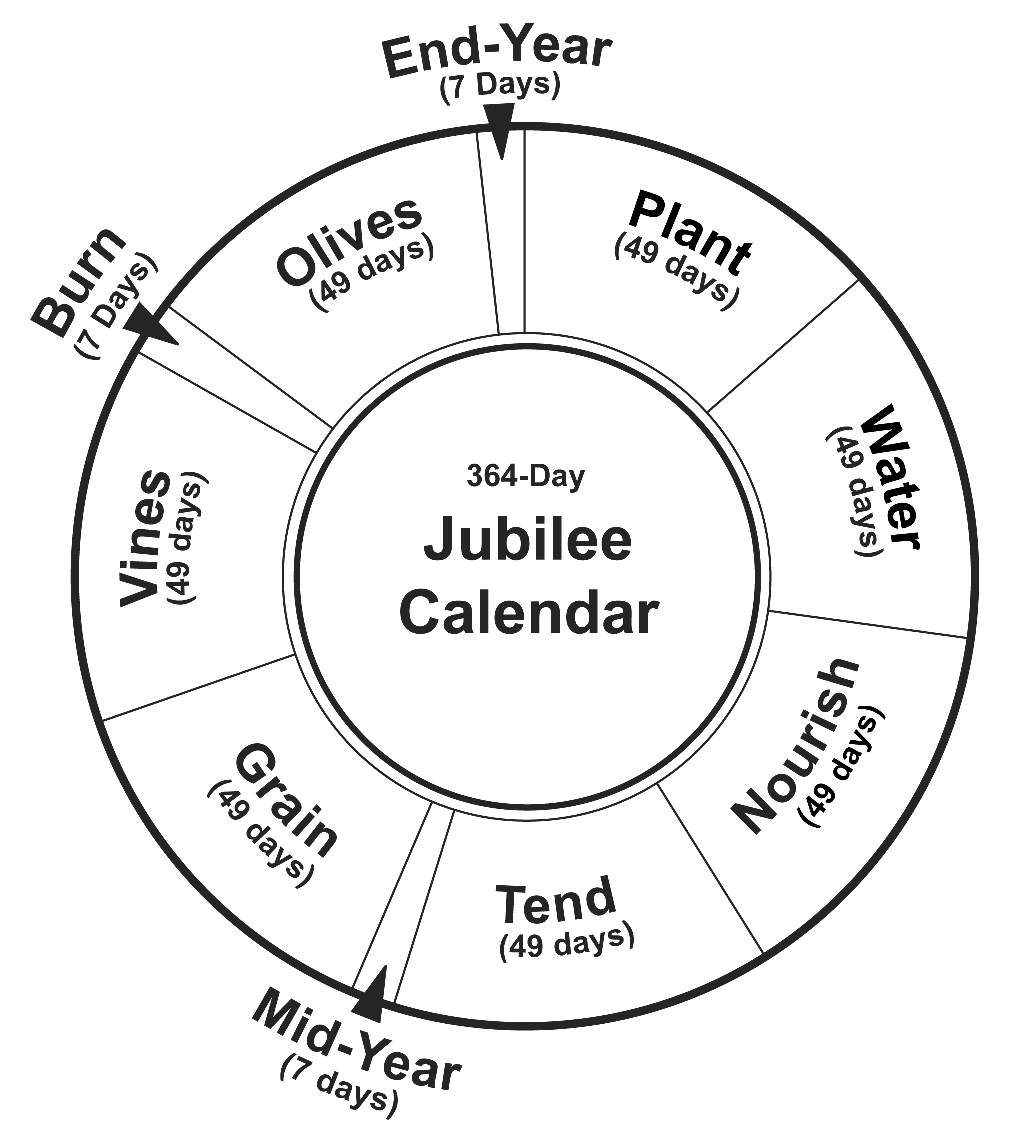 |
Figure 1. The Jubilee Calendar divides time into sevens.
Before looking at those events, it is important to note that almost all of the Book of Numbers in the
Old Testament occurred in either the second or very last of the forty years that Israel spent in the
wilderness. It is not obvious on a first reading that 38 years are covered in only a few
chapters. The exodus from Egypt and the events of the first year after are recorded in the Book of
Exodus. The law of Moses was given at the beginning of the second year and it is found in the
Book of Leviticus. The Book of Numbers begins describing other events of the second year. The
episodes of Miriam's withered hand, and the twelve spies and forty days occurred that summer,
are described in Numbers 12-14, where the Lord told them they would wander for 40 years in the
wilderness because of their unbelief. A mere six chapters later we are told Miriam died in the first
month (Num. 20:1). The Book of Jasher, an excellent source for dates,[7] adds that her death
occurred in the fortieth year (Jasher 84:24).
If so, then all of the following events occurred in the
last year in the wilderness: the death of Miriam (Num. 20:1), the smiting of the rock at Meribah
(Num. 20:11), the death of Aaron (Num. 20:28), the Brazen Serpent (Num. 21), the prophecy of
Balaam (Num. 22-24), and the capturing and distribution of lands of inheritance on the east side of
Jordan (Num. 31-32). A confirmation that all of those events indeed occurred in that last year is
that in the scriptural review of the entire journey, Aaron's death date is explicitly given as the first
day of Ab in the fortieth year (Num. 33:38). The entire book of Deuteronomy was given beginning
in the 11th month of that year (Deut. 1:3), in Jan. 1422 BC, and then Moses was translated ("died"
in Deut. 34:1) after Joshua was given command.
Right at the beginning of the 41st year (in Apr, 1422 BC), the Jordan River was parted and Israel
finally entered into the promised land of Canaan (Joshua 3-4). Shortly afterward they celebrated
the passover (Josh. 5:11), and then took the city of Jericho (Joshua 6).
1.1 Proposed Dates
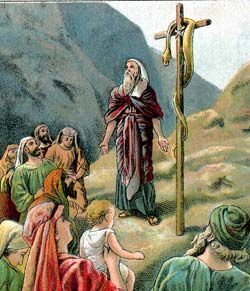 |
The Brazen Serpent
Some precise dates have already been proposed for those events. One of the most important was
the raising of the Brazen Serpent. My proposed date for that event is Sat 19 Sep 1423 BC, being a
holy day on six sacred calendars.[8] It occurred right at the beginning of the Jubilee year
according to the Hebrew calendar and on the Great Day of Atonement at the very end of the last
year on the Jubilee calendar. The giving of Deuteronomy was in the jubilee year according to both
calendars.
1.2 Passing Over Jordan
One date which is given explicitly in the Bible, but which has not yet been mentioned in my articles
is the precise date of passing over the Jordan River into the Promised Land. The Book of Joshua
explicitly gives that date, being 10 Nisan, exactly 40 years after the first passover lambs had been
chosen at the Exodus (Ex. 12:3). On our calendar, using the Perpetual Hebrew Calendar, that date was
Mon 12 Apr 1422 BC.
1.3 The Fall of Jericho
Now we come to a date which has eluded me until now. The story of the falling of the walls of
Jericho at the blast of the trump is one of the strangest stories in the entire Bible, and seems loaded
with calendrical significance. Let's review this unusual story and then determine the date.
Shortly after passing over Jordan, Joshua was commanded to conquer the city of Jericho in a very
peculiar manner. Afterwards, the taking of the other cities of Canaan was much more routine. But
in the case of Jericho, Joshua was commanded to have his army encircle the city once per day for
six days. Accompanying the army were to be seven priests, each bearing a trumpet, and carrying
the sacred ark of the covenant. On the seventh day, the group was to encircle the city seven times,
after which the priests were to give a long, loud blast on their trumpets. At that time, the entire
army was to shout, and the walls would fall to the ground, rendering the city an easy mark to
conquer (Joshua 6:3-6).
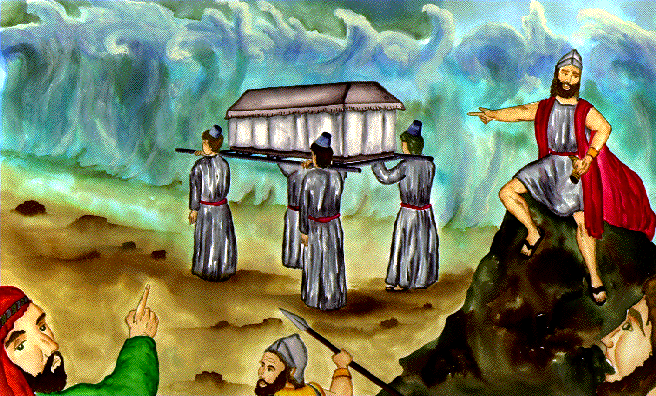 |
Crossing the River Jordan
It would have been interesting to hear the army commenting to each other on Joshua's plan as they
marched around the city. Have you ever heard of stranger battle tactics? It has seemed clear to me
that this entire scheme was designed to symbolize an important future event, but the interpretation
has eluded me. The seven priests might represent the seven angels of the last days, each of which
blows a trump (Rev. 8:2-11:15). These priests were to give one long blast. Such a sound is often
associated with the earth quaking, as at the giving of the Ten Commandments on the day of
Pentecost, when the "whole mount quaked greatly" and the "voice of the trumpet sounded long,
and waxed louder and louder" (Ex. 19:18-19). Such a "long and loud" blast is also associated
with events preceding the Second Coming, including the resurrection of the dead (D&C 88:94-98).
The battle plan also seems to indicate a date on the calendar. The encircling of the city might
represent seven cycles of time. Moreover, the seven angels giving the blast on the trumpet is
clearly reminiscent of the seven priests who each did likewise on the Feast of Trumpets, which
occurs on the first day of the seventh month on the Hebrew Calendar. While that event seems to
represent the seven angels who each give their blast at the opening of the seventh millennium to
announce the Second Coming of the Savior, what has been a problem is that the fall of Jericho
happens about a month after Passover in the spring (Joshua 5:11), rather than in the autumn as
does the Feast of Trumpets.
As this article was in preparation, the search was again made for the date of the fall of the walls of
Jericho and now the answer seems so obvious that it is amazing that it was not discovered earlier.
The Feast of Firstfruits occurs seven weeks after the ceremony of the Waving of the Sheaf of
barley, which in turn occurs on the Sunday following Passover.[9] That waving is
equivalent to "Easter" on the Hebrew calendar because it represents the offering of the firstfruits of
the ground (1 Cor. 15:20). The modern Christian Easter also usually falls on the Sunday after Passover. The Feast of Firstfruits is also called the "Feast of Weeks" because of the seven times seven interval.
Moreover, that feast also occurs on the "fiftieth" day, counting Easter as the first, and hence it is
similar to the "jubilee" which occurs on the fiftieth year after seven weeks of years. Thus the same
feast was later called "Pentecost" in Greek, where the "pente" refers to the "fifty" symbolism. Note
that the Day of Pentecost, which always occurs on Sunday on the Perpetual Hebrew Calendar, is
counted as the fiftieth day from Easter Sunday, even though they are separated by seven weeks (49
days), because Easter is counted as the first day.
 |
The Fall of Jericho.
With all of that in mind, let us now consider the Feast of Firstfruits (Pentecost) as a possible date
for the Fall of Jericho. Passover that year was celebrated on the evening preceding Sat 17 Apr 1422 BC.[10] The manna ceased to appear in its weekly cycle the following Sunday morning (Joshua 5:12), which was Easter Sunday, 18 Apr 1422 BC. The disappearing of the manna from the earth clearly represented the return of Jesus Christ to heaven, he being the true manna from heaven (John 6:31-35, 48-51). Note the wonderful significance that the manna returned to heaven on Easter Sunday, the same day on which the Savior resurrected. That Easter morning had two other things in common with the morning of the Savior's resurrection: it was also Easter on the Jubilee calendar and the day of the Priest cycle representing resurrection.[11]
Counting seven weeks from that Easter brings us to Sun, 6 Jun 1422 BC, the Feast of Firstfruits,
as the proposed day for the Fall of Jericho. That turns out to have been a holy day on at least five
sacred calendars. In addition to being Pentecost, it was 13 Serpent on the Sacred Round (as was
"Brazen Serpent Day"), Firstfruits (of Wine) on the Jubilee calendar, 0 Prime (Mercury), and 1
Summer on the Enoch Fixed calendar.[12] With all of those testimonies that the day
was special, there is no doubt in my mind that finally the date of the Fall of Jericho has been
found.
2. Upcoming Celebration Dates
There will be an anniversary date of each of the above events coming up in the seventieth jubilee
year. The fact that the year is not just any jubilee, but marks exactly seventy jubilees from Moses
and Joshua makes it a special year indeed.[13]
Here is a table of coming anniversary dates:
| Event | Date | Remarks |
|---|
| Brazen Serpent | Sat 20 Sep 2008 | Great Day of Atonement (Jubilee Calendar; day OOooo, once in 49 years). |
| Jubilee Year Begins | Sun 28 Sep 2008 | On Jubilee Calendar (day PPppp); also 1 Autumn (Enoch). |
| Jubilee Trumpet Sounds | Sat 11 Oct 2008 | Day of Atonement (PHC, see Lev. 25:9). Also Tabernacles (Enoch) and End of Vine Harvest (Jubilee Fixed) |
| Deuteronomy | Wed 28 Jan 2009 | 1 Shebat (PHC). |
| Crossing Jordan | Sun 5 Apr 2009 pm* | 10 Nisan (PHC), 1 Serpent (SR), 1 Res (V), 1 Birth (M). |
| Manna Stops | Sun 12 Apr 2009 | Easter Sunday, also Easter on Hebrew, Enoch;
Passover on Jubilee |
| Fall of Jericho | Sun 31 May 2009 | Firstfruits (PHC and Enoch) |
Most of these dates are not outstanding on their own, but only in commemoration of great events
of the past. On the other hand, one of these date is amazing by itself: the anniversary of the
Crossing of the Jordan River.
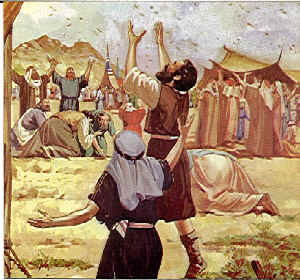 |
The bread from heaven symbolized Christ.
2.1 Crossing the Jordan
The discovery of this upcoming date was really the motivation for this entire article. The evening of Sunday 5 Apr 2009 pm* (meaning from 6 pm until midnight) is a holy time on four sacred calendars. It not only begins Mon 10 Nisan on the Perpetual Hebrew Calendar, it is also the day 1 Resurrection on
the Venus calendar. 10 Nisan only occurs on one of the four principal holy days on the Venus
calendar once in 146 years,[14] so that alignment alone is impressive. But in addition, the day will also be 1 Birth on the Mercury calendar and the day 1 Serpent on the Sacred Round. Moreover, on our (not so sacred) Gregorian calendar, the Savior was also born on the evening preceding 6 April, so it will be an anniversary of his birth. But the real alignment is with the birth of Isaac.
2.2 Isaac's Birthday
It has already been proposed that by far the most likely date for the birth of Isaac, the son of
Abraham, was on Tue, 10 Nisan, 16 Mar 1952 BC.[15] That day was also 1 Serpent (Sacred Round), 1
Resurrection (Venus) and 1 Birth (Mercury). That is, it was exactly the same holy day on all four
of those calendars as is the upcoming anniversary of the crossing of the Jordan River. Let us
consider just how rare of an event that is.
Consider any given date on the Hebrew Calendar, such as your own birthday. It was also some day on the Venus, Mercury and Sacred Round calendars. How often will the day repeat on all four of those
calendars? The same Hebrew day usually repeats once per year, it is also the same on the Venus
calendar once in 584 years (on the average), and also on the Mercury calendar once in 5,200 years,
and also on the Sacred Round only once in 105,000 years. That is, most of the time any given date
on all four of those calendars does not repeat even once in the 7,000 years of the history of Adam's
family in mortality. To be precise, there is only a 1/15 chance that any one date will repeat even
once.[16] So if we were to check 15 birth dates of great prophets, we would expect
about one to repeat sometime in history. I checked several such dates, looking at the proposed birth dates of several of the Biblical patriarchs, such as Abraham, Ishmael, Jacob, Adam, Enoch, Moses, etc.
and also as many of their wives as I could, such as Rebekah. The only date that I found that
repeated even once in that 7,000-year interval was the birth date of Isaac.
Now, if the date of Isaac had repeated at some random time, such as in AD 743, then it could be
chalked up to chance because we would expect to find about one date in 15 repeating at some time. But the fact that the one date which I found which was not unique in history just happens to repeat on the
exact day of the seventieth jubilee anniversary of Joshua's crossing the Jordan makes the day jump out from the crowd as an outstanding anniversary indeed, worthy of my reporting.
As stated repeatedly in my past articles, I have no idea if anything special might happen on
that date. It is only being reported here so that in case something of religious significance does occur, it will be a witness that God had planned it millennia ahead of time. In fact, the birth of Isaac was also unique in scripture in that God actually prophesied to Abraham the exact day on which Isaac would be born, being exactly one year from that holy day ("set time" in Gen. 17:21). Thus, the birth of Isaac
seems to have been on a special day indeed.
3. Conclusion
According to the proposed dates from my research, the year from about Sep 2008 through Sep
2009 will mark the seventieth jubilee year from the events of the last year of Moses leading the
children of Israel through the wilderness and of Joshua crossing the Jordan River into the
promised land of Canaan. It would be a good time to commemorate the raising of the Brazen
Serpent, the giving of the Book of Deuteronomy, and even the Easter Sunday on which the manna
ceased to come from heaven. But of all of the days to celebrate, the most outstanding will be the
anniversary of Joshua's miraculous crossing of the River Jordan. The quarter-day beginning at 6 p.m. on Sun 5 Apr 2009 is a once-in-history repetition of the date of the birth of Isaac on four sacred calendars.
Notes
- Many proposed dates during the life of Moses are found in Pratt, John P., "Exodus Date Testifies of Christ" Meridian Magazine (7 Oct 2003). The precise date of the actual passing over of the River Jordan has not, however, been published until this time. All Hebrew calendar dates in this article are given according to the Perpetual Hebrew calendar, which occasionally differs slightly from the traditional Hebrew calendar. It has been proposed by the author as being more accurate.
- The author thanks his good friend Ronald P. Millett for pointing out the fact that the coming jubilee year is the seventieth since Crossing the Jordan, and for suggesting this article. As for the exact date, this is an example of where the Perpetual Hebrew Calendar differs from the traditional, on which 10 Nisan occurs on Sat 4 Apr 2009.
- The more traditional interpretation is that they started the count after Joshua divided the land, so that crops could be planted.
- This agrees with the standard Jewish tradition. For example, the Book of Jubilees refers exclusively to a jubilee of 49 years.
- See Pratt, John P., "Jubilee Calendar Testifies of Christ" Meridian Magazine (17 Nov 2004) for a discussion of the Jubilee Calendar in general, with Section 2.3.6 proposing that the entering of Canaan occurred in a jubilee year.
- Remember there was no year AD 0; the year preceding AD 1 was 1 BC. To simplify calculations astronomers refer to 1422 BC as -1421. So 2009 - (-1421) = 3430 years = 70 x 49 years.
- See Pratt, John P., "How Did the Book of Jasher Know?" Meridian Magazine (7 Jan 2002).
- It was the Great Day of Atonement (OOooo) on the Jubilee calendar, 13 Serpent (Sacred Round), the Autumn Equinox (Enoch), the Feast of Tabernacles (Enoch Fixed), 0 Birth (Mercury), and 1 Bil (Priest). See Pratt, John P., "Jubilee Calendar" op. cit., Section 2.3.4.
- At the time of Christ the Sadducees celebrated the Waving always on the Sunday after Passover, whereas the Pharisees did so on the day following Passover. Modern Hebrews follow the Pharisees, but the Perpetual Hebrew Calendar employs the Sadducees tradition. See Pratt, John P., "Exodus" op. cit., Section 3.1.4.
- At the time of Moses and Joshua the day began at sunrise. On that calendar, Passover occurs on the evening ending 14 Nisan (Josh. 5:10), they ate the unleavened cakes on the beginning of the Feast of Unleavened Bread on Sat 15 Nisan (Josh. 5:11), and the manna ceased on the next day Sun 16 Nisan (Josh.5:12). Note that this sequence makes it clear on which day of the week each of these events occurred, because the manna ceasing clearly occurred on Easter Sunday. After the Babylonian captivity (and before Moses) the Hebrew day began in the evening, on which calendar Passover coincides with the beginning of the Feast of Unleavened Bread, both beginning on the evening of Friday, which begins Sat 15 Nisan. These details are so confusing that most scholars have not understood them. To avoid confusion, I use the modern notation throughout my articles.
- See Pratt, John P., "Jubilee Calendar" op. cit., Section 2.3.6.
- The Enoch Fixed (EF) year was also sacred, being 1 LATE SPRING. If it was an earthquake that caused the walls of Jericho to fall, then this double holy day on the Enoch Fixed calendar matches the results that deadly earthquakes tend to happen on EF holy days/years (see my "Tsunami on the Feast of Trumpets", Section 3.5). If the Fall of Jericho symbolizes a great future earthquake and if that earthquake follows the pattern of EF holy days, then the indicated day might be Sat 31 Dec 2011, which is the day 14 Autumn (Tabernacles) in the year 17 MID AUTUMN ("Deluge Day," being both the day and year of the Great Flood) on the Enoch Fixed calendar. That combination only occurs once in 364 years, and it occurred on the day Noah entered the ark (see Ark Day in "Tsunami", Section 2.4, Table 1). Moreover, that coming day is also 13 Serpent (Sacred Round), the same as the Fall of Jericho. The next day Sun 1 Jan 2012 is 1 Skull, and that same article also indicated that deadly earthquakes are associated with the day Skull (Sacred Round). I am not making an earthquake prediction here because that is only one of a multitude of sacred dates on which a future great earthquake could occur. But it would not be surprising to me that after such an earthquake happens, it might turn out that it was somehow prefigured by the Fall of Jericho.
-
The grouping of jubilees into larger units is not totally understood at this time. It currently
appears that there is a unit which could be called a Grand Jubilee, which would be composed of 7
jubilees, or 7x7x7 = 343 years. If so, then 2009 marks 10 Grand Jubilees from 1422 BC, so that
makes it more rare than just any jubilee. Moreover, the next larger grouping appears to be what
could be called the Millennial Jubilee comprising 3 Grand Jubilees, or 1,029 years. The earth's
temporal history could also be divided into seven Millennial Jubilees (see my "Jubilee Calendar", Sections 1.4-1.5). How would that correlate to our calendar? Christ was born in
a jubilee year, and the Fifth Millennial Jubilee would most likely have begun on Sun 3 Oct 2 BC, a
few days prior to the birth of John the Baptist (see "Jubilee Calendar" section 3.3). If so, then the
Seventh Millennial Jubilee will begin on Sun 30 Sep 2057. In the Jubilee calendar pattern, there is a little season before the seventh period, called "The Burning" (See Figure 1). When applying the jubilee
pattern to the seven Millennial Jubilees, the "Burning" refers to the jubilee prior to the seventh
Millennial Jubilee. That would be the upcoming jubilee discussed in this article, beginning Sun 28 Sep 2008. Thus, the coming "Burning Jubilee" of 49 years might well include the "Burning of the Fields", being the destruction of the wicked in preparation for the coming of the Savior.
- The four major holy days are 1 Creation, 1 Birth, 1 Prime and 1 Resurrection. The chance of being one of those four days every 584 days is 4/584 or 1/146.
- See Pratt, John P., "Divine Calendars Testify of Abraham, Isaac, and Jacob" Meridian Magazine (11 Sep 2003), Section 4.4.
- To fall randomly into one of a given 7,000 years out of 105,000 possible is a chance of 7,000/105,000 or 1/15.






